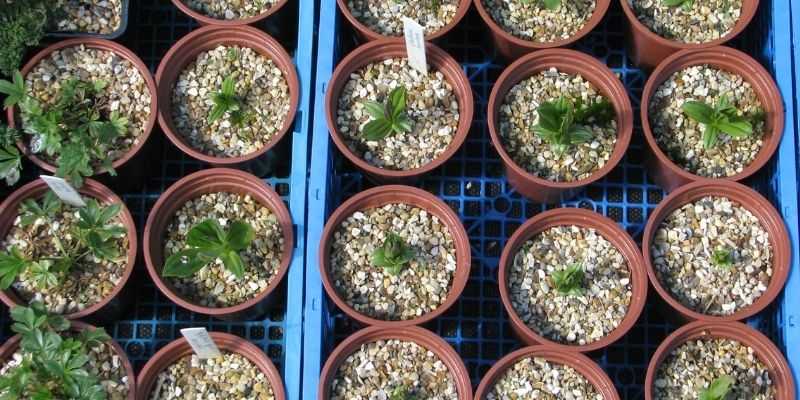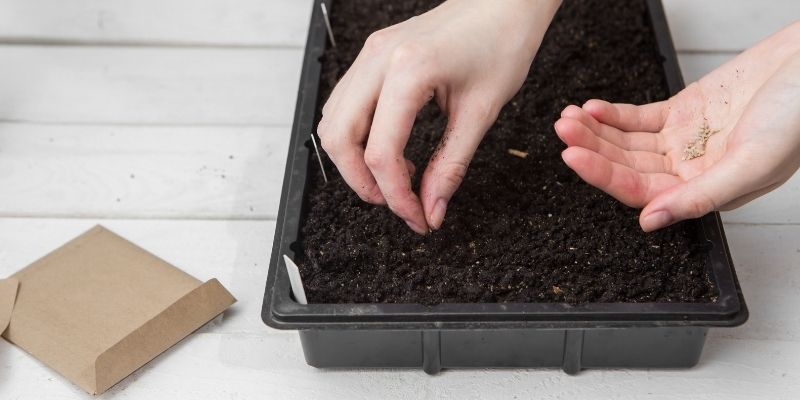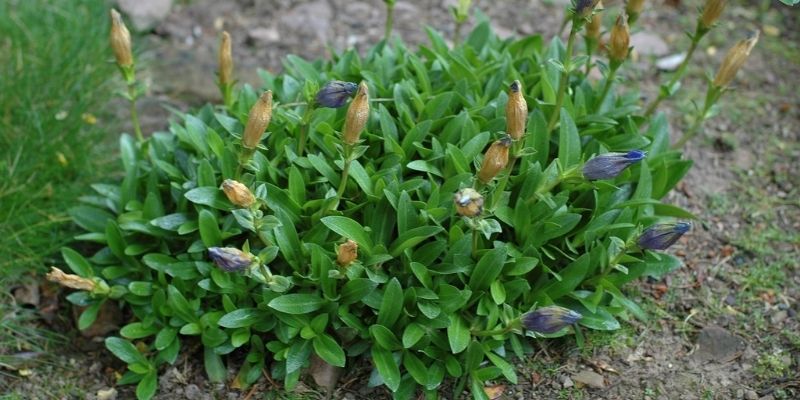Growing wild in mountainous areas, gentian is a hardy perennial producing beautiful trumpet-shaped or star-shaped, very colourful flowers. Mat-forming or erect, it always makes a statement in a cool rockery! Whether it’s blue gentian or yellow gentian (Gentiana lutea) used for medicinal properties or for liqueur production, this very attractive alpine plant can be propagated by different techniques: sowing, division of stump or propagation by stem cuttings. If you feel like planting it in your garden, discover our tutorial to learn everything about propagating gentian!

(photo peganum - Flickr)
Propagation of gentian by sowing
When to sow gentian seeds?
Sowing gentian should be done in autumn, under a cold frame. Preferably use fresh gentian seeds, as germination of old seeds is slower and irregular.
How to sow gentian?
Required equipment :
- mini greenhouse (or perforated seed tray)
- seed compost
- coarse sand or clay balls
- gentian seeds
- spray bottle
Sowing gentian :
To trigger germination, seeds need a period of stratification during which they are kept cold and moist. These winter conditions will soften seed coat, promote gaseous exchanges and thus break dormancy. There are two options : place seeds in a plastic bag in the fridge for two months and then sow them in a seed tray at the start of spring, or sow in autumn and place the tray outdoors until seeds germinate.
- Line bottom of mini greenhouse with a draining layer (2 cm of sand or clay balls) then cover with seed compost;
- Moisten and press lightly;
- Evenly distribute seeds on surface;
- Sprinkle a very fine layer of compost over seeds to barely cover them;
- Water gently using spray bottle;
- Cover with lid (bag or glass plate);
- Keep substrate moist.
To germinate seeds by natural stratification, place seed tray outdoors (temperature between 0 and -5°C) and in darkness. Gentian growth is rather slow, seed emergence usually occurs within three months. As soon as seedlings appear, place tray in a warmer spot not exceeding 18°C, for example a greenhouse or conservatory. Monitor growth and remove lid occasionally to air and prevent disease. Thin seedlings if necessary and pot them into individual buckets when large enough to handle. Planting out into soil can be done the following spring, taking care not to damage roots.

Propagation of gentian by dividing clumps
When to divide gentian?
Division of gentian can be carried out in early spring for species flowering in autumn or in early autumn for those flowering in spring or summer. Carry out operation in moist conditions, which makes lifting rootball easier. This simple method consists in separating very dense clumps to rejuvenate plant, stimulate growth of new roots and thus preserve a more floriferous plant for longer. Use this technique every three years, mainly for species with a mat-forming habit, such as Alpine gentian or spring gentian, both producing blue flowers. Species forming a rosette of leaves cannot be divided, like Gentiana lutea with yellow flowers.
How to divide gentian?
Required equipment :
Dividing gentian :
- Select a vigorous plant.
- Mark out a wide circle around rootball using fork-spade or spade.
- Insert tool vertically all round plant to form circle.
- Use leverage on handle to lift rootball and dig it up without damaging roots.
- Divide clump into two or three parts using a spade or, if necessary, a sharp knife.
- Replant clumps immediately in desired spots, in free-draining soil worked and enriched with compost.
- Firm soil gently and water thoroughly.
- Mulch gentian plants to retain soil moisture.
- Continue regular watering, especially during hot spells.

Propagation of gentian by cuttings
When to take gentian cuttings?
This technique is practised in late spring on some species, such as Gentiana verna, Gentiana scabra or Gentiana sino-ornata.
How to take gentian cuttings?
Required equipment :
- gravel
- sand
- garden soil enriched with turf or humus
- clay balls
- pruning shear or knife
- rooting hormone
- pencil
- bucket
- cloche, bottle or bag
- spray bottle
Taking gentian cuttings :
- Prepare cutting substrate by mixing gravel, garden soil and sand.
- Fill bucket with a layer of clay balls (2–3 cm) then add substrate and moisten.
- Take a gentian shoot 7–10 cm long not bearing flowers or buds, cutting below a node. You can also choose a creeping branch on edge of plant that has already formed natural rootlets.
- On stem, remove lower leaves and leave a rosette of leaves at top.
- Dip cutting into root activator.
- Make a hole in substrate and insert cutting.
- Water without wetting leaves.
- Ensure substrate remains constantly moist.
- Cover with a cloche (this is an enclosed cutting) and place cutting in a shaded, cool spot.
It is possible to place several cuttings in the same pot. In that case, use a pot 20–30 cm in diameter and position cuttings spaced apart and near pot edge. Remember to remove cloche every 2–3 days, as excessive condensation can rot cuttings. You can plant cuttings out in ground the following spring.

For your cutting, choose a healthy stem that has not flowered. Here Gentiana sino-ornata (photo Carstor - Wikimedia)
Further reading
⇒ Learn all about Gentian: planting, cultivation and maintenance
⇒ Find our tips for choosing a gentian
⇒ Discover all stages of sowing in a seed tray
⇒ Learn all about propagation by cuttings: everything you need to know about different techniques and our advice and root activators: an asset for propagation by cuttings
































Comments